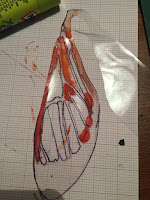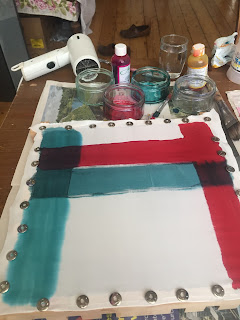 |
| Image for sketchbook day https://evrymom.tumblr.com/post/95315216678/isis0isis-fractured-slate |
I chose this image of fractured slate to work on today because:
There are only two colours, both of which are in my palate.
I wanted to practice drawing sharp lines.
The overlapping slates of different sizes and shapes are interesting in their own right, and keep the eye moving
 |
| Dark places Black pencil |
 |
| Fine lines |
 |
| Adding the base colour blue I didn't have exactly the same blue as the image, so made it using this colour for the base and a more turquoise blue (see left of sketchbook) on top. |
 |
| Adding the second colour I discovered the need for yellow and bright salmon pink as well |
 |
What I learned:
Using the colour intensities for perspective works well
I need a pale sky blue pencil!
Part of the appeal of the image was the overall intensity of colour, which is missing in my sketch
The shadows work a lot better in brown than black or grey.
The lines aren't sharp enough, and the pencil lines detract.
Next time:
Pick a smaller region of the image
Abstractify
Use gouache for the colours, with intensity all over
What it looked like when I did this:
 |
| I like the way this looks (apart from the poorly focussed blur). I didn't have time today to add colour |










































